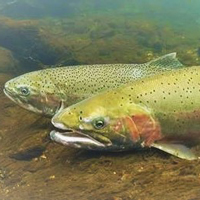Join the Museum for an illustrated presentation about steelhead trout, a unique species for which the environment determines how different individual fish develop. In a talk titled “From Ridgetop to Wavetop,” NOAA fisheries biologist Sean Hayes will discuss the life history decisions, habitat use, ocean migration and predator/prey interactions of steelhead. His research has focused on steelhead of the Central Coast, specifically a 12-year study at a small watershed located just north of Santa Cruz.
Most coastal California steelhead (such as those in the Carmel and Big Sur Rivers) are federally listed as threatened under the Endangered Species Act. Stocks situated in rivers farther south are listed as endangered. The fish require connected watersheds from the upper reaches of the rivers down through estuaries and into the ocean. Water flow in the upper watersheds of these rivers is at constant risk of being reduced by drought and by human consumption demands. In addition, summer flows must be low enough for sandbars to build up (thus forming a lagoon) but high enough that the lagoon does not leach through the sand bar. This has become a critical management issue that will probably only increase in importance over time.
show less
Most coastal California steelhead (such as those in the Carmel and Big Sur Rivers) are federally listed as threatened under the Endangered Species Act. Stocks situated in rivers farther south are listed as endangered. The fish require connected watersheds from the upper reaches of the rivers down through estuaries and into the ocean. Water flow in the upper watersheds of these rivers is at constant risk of being reduced by drought and by human consumption demands. In addition, summer flows must be low enough for sandbars to build up (thus forming a lagoon) but high enough that the lagoon does not leach through the sand bar. This has become a critical management issue that will probably only increase in importance over time.
Join the Museum for an illustrated presentation about steelhead trout, a unique species for which the environment determines how different individual fish develop. In a talk titled “From Ridgetop to Wavetop,” NOAA fisheries biologist Sean Hayes will discuss the life history decisions, habitat use, ocean migration and predator/prey interactions of steelhead. His research has focused on steelhead of the Central Coast, specifically a 12-year study at a small watershed located just north of Santa Cruz.
Most coastal California steelhead (such as those in the Carmel and Big Sur Rivers) are federally listed as threatened under the Endangered Species Act. Stocks situated in rivers farther south are listed as endangered. The fish require connected watersheds from the upper reaches of the rivers down through estuaries and into the ocean. Water flow in the upper watersheds of these rivers is at constant risk of being reduced by drought and by human consumption demands. In addition, summer flows must be low enough for sandbars to build up (thus forming a lagoon) but high enough that the lagoon does not leach through the sand bar. This has become a critical management issue that will probably only increase in importance over time.
read more
Most coastal California steelhead (such as those in the Carmel and Big Sur Rivers) are federally listed as threatened under the Endangered Species Act. Stocks situated in rivers farther south are listed as endangered. The fish require connected watersheds from the upper reaches of the rivers down through estuaries and into the ocean. Water flow in the upper watersheds of these rivers is at constant risk of being reduced by drought and by human consumption demands. In addition, summer flows must be low enough for sandbars to build up (thus forming a lagoon) but high enough that the lagoon does not leach through the sand bar. This has become a critical management issue that will probably only increase in importance over time.
show less
Date/Times:
165 Forest Ave, Pacific Grove, CA 93950
The Best Events
Every Week in Your Inbox
From Our Sponsors
UPCOMING EVENTS
Great suggestion! We'll be in touch.
Event reviewed successfully.









